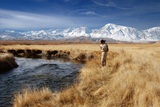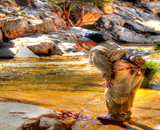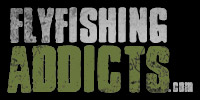C&R, 10 Tips for a Successful Release
After seeing someone on another forum handle fish with dry hands before releasing them back into the water. I figure it is time to remind people how to properly release fish so they will have the best chance of survival. With the coming of summer and warm water, along with our drought conditions it is important that we all practice proper C&R techniques that allow the fish the best chance to live through these tough conditions. This should be posted permanently at the top of a section so members can easily find and view it at any time.
Following are 10 tips for insuring that your catch makes it back into the water for another angler to pursue. While these guidelines are written from the perspective of the trout and salmon fisherman, virtually all of these guidelines apply to other species as well. Click on the links for more useful information.
http://www.hatchmag.com/articles/trout- ... hot/771553
http://www.hatchmag.com/articles/under-pressure/77147
Use Crimped or Barbless Hooks
This is the obvious one, so let's get it out of the way first. Use hooks with no barb whatsoever, or use your pliers or hemostats to press down the barb on your hook before fishing it. Barbless hooks are almost always removable with ease. Barbed hooks can often cause serious damage to your catch and probably aren't increasing your landing rate as much as you think. Get a “Ketchum Release Tool”; it will make releasing a fish a snap without touching the fish at all. I think it is the best streamside gadget ever made. http://www.youtube.com/watch?v=xptYPB7KCos
You're No Surgeon
Well, at least we're assuming you're not. Even if you are a surgeon, don't try to perform surgery streamside on an un-sedated subject. If your fish takes a hook deep and it can't easily be removed, just cut the leader/tippet as close as you safely can and leave the hook in. The fish will eventually shed the hook on its own, the hook will corrode, or new tissue will surround the hook and the fish will go on about its business of being a fish. The alternative, attempting to dig out a deep hook, almost invariably results in a mortally wounded fish. In fact, one study by the PFBC (Pennsylvania Fish and Boat Commission) showed that 66 percent of deeply hooked fish that were released with the hook still in place survived. Their counterparts that had the hook dug out? They survived only 11 percent of the time.
Horse It In
Ditch the 8x tippet and fight your fish in with authority. Apply pressure properly from the side and don't over play the fish. Playing a fish for 10 minutes (that's intended as a gross exaggeration, it can take much less time than that to excessively exhaust a trout, for example) on tippet that's too light for the fight is likely to exhaust a fish past a point from which it can recover. Chances are you don't need that ultrafine tippet anyway.
Use a Rubber Net
Landing nets provide one of the few reliable ways to release a fish without handling the fish at all and also allow you to land a fish more quickly. Try to use a net whenever possible and use a good quality catch and release net like the rubber mesh variety that are increasingly common and increasingly affordable these days. Stay away from nylon nets. Buy a net from Greg @ http://www.sierra-nets.com/CMS-Sierra/
Get Wet
When it comes time to handle the fish, always get your hands wet. Dry hands are much more likely to remove a fish's layer of slime which protects the fish from fungus, bacteria and parasites.
Take Care of the Head and Eyes
Like you, the fish at the end of your line relies on its head and eyes to get by. Unlike you, however, a fish doesn't have a head designed to take the occasional whack or two. A fish's head is fragile and needs to be protected. In fact, head injuries are the leading cause of fish mortality after release.
Avoid the Shore
Never land your catch by dragging it onto the rocks, beach or even grass along the shoreline. These places are no place for a fish. Putting a fish on the shore virtually guarantees you're committing all kinds of no-nos: disturbing the fish's protective slime, keeping the fish out of the water too long, encouraging head and eye injuries and more. Keep your catch in the water where it belongs if you're hoping to release it unharmed.
5 Second Rule
This isn't the same 5 second rule that applies to dropping french fries or funnel cake at the ballpark. This version, much more well-rooted in science than the aforementioned version, requires that you strictly limit the time your fish spends out of water. This doesn't mean you've lost all hope of getting that grip-and-grin shot, it just means you need to do it properly. Prepare for your photo with your fish safely under the surface. When you lift the fish out of the water, do it for 5 second intervals or less. Feel free to keep on trying (within reason) until you get the shot, but return your fish to the water for a rest between attempts.
Revive it Properly
Face your fish upstream (or whichever direction faces into the current), not down, and let it breathe normally. If you've been taught by someone in the past to drag your catch back and forth in the water in order to help it revive, stop. This sort of action actually impedes the fish's ability to move water through the mouth and across the gills to obtain oxygen. Also take care not to revive your fish in sediment-filled water. If you've disturbed the stream bed, move into clean, clear water with a moderate flow and revive the fish there. Be patient and let the fish tell you when it is ready to swim away. Returned vigor and stability of the fish will be the first signs that it is nearing the time for release.
Watch the Thermometer
Trout and salmonids are in increased danger of stress and exhaustion as water temperatures increase and oxygen levels decrease. Pay attention to stream temperatures as air temperatures increase and the season moves on. Know your target species and how hot is too hot for the fish you're pursuing. As temperatures approach the limits of what is safe, take extra care in all aspects of safe catch and release. Best to not even fish if the chances of the fish’s survival are slim, or if you must fish, do it early in the morning before the water temps go beyond the fish’s upper limits of survival.
Practice these C&R techniques and you should be able to come back and enjoy fishing your favorite streams and lakes for years to come!
REALTIME FLOWS  U. Kern: n/a cfs
U. Kern: n/a cfs
 L. Kern: 1341 cfs
L. Kern: 1341 cfs
 E.W: 312 cfs
E.W: 312 cfs
 U. Owens: 108 cfs
U. Owens: 108 cfs  L. Owens: 496 cfs 09/02/19 1:15 PM PST
L. Owens: 496 cfs 09/02/19 1:15 PM PST
C&R, 10 Tips for a Successful Release
4 posts
• Page 1 of 1
C&R, 10 Tips for a Successful Release
Make Fly Fishing Great Again!
-

fly addict - Posts: 2560
- Joined: August 3rd, 2008, 1:57 pm
- Location: In your honey hole!
Re: C&R, 10 Tips for a Successful Release
Good reminders. I always cringe when I see the "flyrod and fish lying in the grass" shots.
"Tomorrow is the most important thing in life. Comes into us at midnight very clean. It's perfect when it arrives and it puts itself in our hands. It hopes we've learnt something from yesterday."
John Wayne
John Wayne
-

Wildman - Site Admin
- Posts: 3747
- Joined: August 17th, 2008, 2:07 pm
Re: C&R, 10 Tips for a Successful Release
Good stuff! I recently read a good article discussing the proper way to grip a trout if removed from the water:
http://www.bishfish.co.nz/articles/fres ... d-kill.htm
http://www.bishfish.co.nz/articles/fres ... d-kill.htm
-

teejay - Posts: 388
- Joined: April 2nd, 2010, 12:00 am
- Location: Nomad
Re: C&R, 10 Tips for a Successful Release
I'd like to add one.
When you are fishing Big fish waters, like Pyramid lake, especially around the spawn, ...leave you're 3 and 4 wt gear at home. A 24 to 30 inch Cut has a tough time as it is, don't make it worse. BobK
When you are fishing Big fish waters, like Pyramid lake, especially around the spawn, ...leave you're 3 and 4 wt gear at home. A 24 to 30 inch Cut has a tough time as it is, don't make it worse. BobK
- BobK
- Posts: 489
- Joined: March 9th, 2011, 12:36 pm
- Location: Owens Valley

